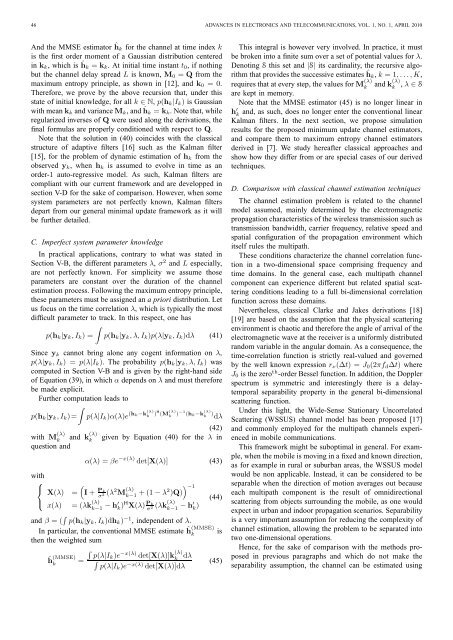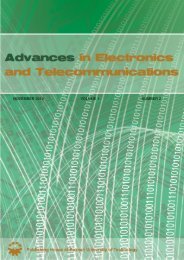channel - Advances in Electronics and Telecommunications
channel - Advances in Electronics and Telecommunications
channel - Advances in Electronics and Telecommunications
You also want an ePaper? Increase the reach of your titles
YUMPU automatically turns print PDFs into web optimized ePapers that Google loves.
46 ADVANCES IN ELECTRONICS AND TELECOMMUNICATIONS, VOL. 1, NO. 1, APRIL 2010<br />
And the MMSE estimator ˆ hk for the <strong>channel</strong> at time <strong>in</strong>dex k<br />
is the first order moment of a Gaussian distribution centered<br />
<strong>in</strong> kk, which is ˆ hk = kk. At <strong>in</strong>itial time <strong>in</strong>stant t0, if noth<strong>in</strong>g<br />
but the <strong>channel</strong> delay spread L is known, M0 = Q from the<br />
maximum entropy pr<strong>in</strong>ciple, as shown <strong>in</strong> [12], <strong>and</strong> k0 = 0.<br />
Therefore, we prove by the above recursion that, under this<br />
state of <strong>in</strong>itial knowledge, for all k ∈ N, p(hk|Ik) is Gaussian<br />
with mean kk <strong>and</strong> variance Mk, <strong>and</strong> ˆ hk = kk. Note that, while<br />
regularized <strong>in</strong>verses of Q were used along the derivations, the<br />
f<strong>in</strong>al formulas are properly conditioned with respect to Q.<br />
Note that the solution <strong>in</strong> (40) co<strong>in</strong>cides with the classical<br />
structure of adaptive filters [16] such as the Kalman filter<br />
[15], for the problem of dynamic estimation of hk from the<br />
observed yk, when hk is assumed to evolve <strong>in</strong> time as an<br />
order-1 auto-regressive model. As such, Kalman filters are<br />
compliant with our current framework <strong>and</strong> are developped <strong>in</strong><br />
section V-D for the sake of comparison. However, when some<br />
system parameters are not perfectly known, Kalman filters<br />
depart from our general m<strong>in</strong>imal update framework as it will<br />
be further detailed.<br />
C. Imperfect system parameter knowledge<br />
In practical applications, contrary to what was stated <strong>in</strong><br />
Section V-B, the different parameters λ, σ2 <strong>and</strong> L especially,<br />
are not perfectly known. For simplicity we assume those<br />
parameters are constant over the duration of the <strong>channel</strong><br />
estimation process. Follow<strong>in</strong>g the maximum entropy pr<strong>in</strong>ciple,<br />
these parameters must be assigned an a priori distribution. Let<br />
us focus on the time correlation λ, which is typically the most<br />
difficult parameter to track. In this respect, one has<br />
�<br />
p(hk|yk, Ik) = p(hk|yk, λ, Ik)p(λ|yk, Ik)dλ (41)<br />
S<strong>in</strong>ce yk cannot br<strong>in</strong>g alone any cogent <strong>in</strong>formation on λ,<br />
p(λ|yk, Ik) = p(λ|Ik). The probability p(hk|yk, λ, Ik) was<br />
computed <strong>in</strong> Section V-B <strong>and</strong> is given by the right-h<strong>and</strong> side<br />
of Equation (39), <strong>in</strong> which α depends on λ <strong>and</strong> must therefore<br />
be made explicit.<br />
Further computation leads to<br />
�<br />
p(hk|yk, Ik)=<br />
(λ)<br />
(hk−k<br />
p(λ|Ik)α(λ)e k )H (M (λ)<br />
k )−1 (hk−k (λ)<br />
k ) dλ<br />
(42)<br />
with M (λ)<br />
k <strong>and</strong> k (λ)<br />
k<br />
question <strong>and</strong><br />
given by Equation (40) for the λ <strong>in</strong><br />
with<br />
⎧<br />
⎨<br />
⎩<br />
α(λ) = βe −x(λ) det[X(λ)] (43)<br />
X(λ)<br />
�<br />
= I + Pk<br />
σ2 (λ2M (λ)<br />
k−1 + (1 − λ2 �−1 )Q)<br />
x(λ) = (λk (λ)<br />
k−1 − h′ k )HX(λ) Pk<br />
σ2 (λk (λ)<br />
k−1 − h′ k )<br />
(44)<br />
<strong>and</strong> β = ( � p(hk|yk, Ik)dhk) −1 , <strong>in</strong>dependent of λ.<br />
In particular, the conventional MMSE estimate ˆ h (MMSE)<br />
k is<br />
then the weighted sum<br />
ˆh (MMSE)<br />
�<br />
p(λ|Ik)e<br />
k =<br />
−x(λ) det[X(λ)]k (λ)<br />
k dλ<br />
�<br />
p(λ|Ik)e−x(λ) (45)<br />
det[X(λ)]dλ<br />
This <strong>in</strong>tegral is however very <strong>in</strong>volved. In practice, it must<br />
be broken <strong>in</strong>to a f<strong>in</strong>ite sum over a set of potential values for λ.<br />
Denot<strong>in</strong>g S this set <strong>and</strong> |S| its card<strong>in</strong>ality, the recursive algorithm<br />
that provides the successive estimates ˆ hk, k = 1, . . . , K,<br />
requires that at every step, the values for M (λ)<br />
k <strong>and</strong> k (λ)<br />
k , λ ∈ S<br />
are kept <strong>in</strong> memory.<br />
Note that the MMSE estimator (45) is no longer l<strong>in</strong>ear <strong>in</strong><br />
h ′ k<br />
<strong>and</strong>, as such, does no longer enter the conventional l<strong>in</strong>ear<br />
Kalman filters. In the next section, we propose simulation<br />
results for the proposed m<strong>in</strong>imum update <strong>channel</strong> estimators,<br />
<strong>and</strong> compare them to maximum entropy <strong>channel</strong> estimators<br />
derived <strong>in</strong> [7]. We study hereafter classical approaches <strong>and</strong><br />
show how they differ from or are special cases of our derived<br />
techniques.<br />
D. Comparison with classical <strong>channel</strong> estimation techniques<br />
The <strong>channel</strong> estimation problem is related to the <strong>channel</strong><br />
model assumed, ma<strong>in</strong>ly determ<strong>in</strong>ed by the electromagnetic<br />
propagation characteristics of the wireless transmission such as<br />
transmission b<strong>and</strong>width, carrier frequency, relative speed <strong>and</strong><br />
spatial configuration of the propagation environment which<br />
itself rules the multipath.<br />
These conditions characterize the <strong>channel</strong> correlation function<br />
<strong>in</strong> a two-dimensional space compris<strong>in</strong>g frequency <strong>and</strong><br />
time doma<strong>in</strong>s. In the general case, each multipath <strong>channel</strong><br />
component can experience different but related spatial scatter<strong>in</strong>g<br />
conditions lead<strong>in</strong>g to a full bi-dimensional correlation<br />
function across these doma<strong>in</strong>s.<br />
Nevertheless, classical Clarke <strong>and</strong> Jakes derivations [18]<br />
[19] are based on the assumption that the physical scatter<strong>in</strong>g<br />
environment is chaotic <strong>and</strong> therefore the angle of arrival of the<br />
electromagnetic wave at the receiver is a uniformly distributed<br />
r<strong>and</strong>om variable <strong>in</strong> the angular doma<strong>in</strong>. As a consequence, the<br />
time-correlation function is strictly real-valued <strong>and</strong> governed<br />
by the well known expression rν(∆t) = J0(2πfd∆t) where<br />
J0 is the zero th -order Bessel function. In addition, the Doppler<br />
spectrum is symmetric <strong>and</strong> <strong>in</strong>terest<strong>in</strong>gly there is a delaytemporal<br />
separability property <strong>in</strong> the general bi-dimensional<br />
scatter<strong>in</strong>g function.<br />
Under this light, the Wide-Sense Stationary Uncorrelated<br />
Scatter<strong>in</strong>g (WSSUS) <strong>channel</strong> model has been proposed [17]<br />
<strong>and</strong> commonly employed for the multipath <strong>channel</strong>s experienced<br />
<strong>in</strong> mobile communications.<br />
This framework might be suboptimal <strong>in</strong> general. For example,<br />
when the mobile is mov<strong>in</strong>g <strong>in</strong> a fixed <strong>and</strong> known direction,<br />
as for example <strong>in</strong> rural or suburban areas, the WSSUS model<br />
would be non applicable. Instead, it can be considered to be<br />
separable when the direction of motion averages out because<br />
each multipath component is the result of omnidirectional<br />
scatter<strong>in</strong>g from objects surround<strong>in</strong>g the mobile, as one would<br />
expect <strong>in</strong> urban <strong>and</strong> <strong>in</strong>door propagation scenarios. Separability<br />
is a very important assumption for reduc<strong>in</strong>g the complexity of<br />
<strong>channel</strong> estimation, allow<strong>in</strong>g the problem to be separated <strong>in</strong>to<br />
two one-dimensional operations.<br />
Hence, for the sake of comparison with the methods proposed<br />
<strong>in</strong> previous paragraphs <strong>and</strong> which do not make the<br />
separability assumption, the <strong>channel</strong> can be estimated us<strong>in</strong>g







